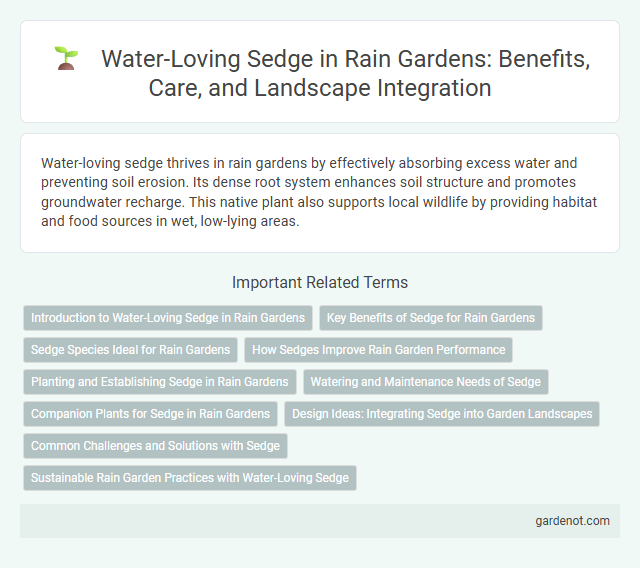Water-loving sedge thrives in rain gardens by effectively absorbing excess water and preventing soil erosion. Its dense root system enhances soil structure and promotes groundwater recharge. This native plant also supports local wildlife by providing habitat and food sources in wet, low-lying areas.
Introduction to Water-Loving Sedge in Rain Gardens
Water-loving sedge (Carex aquatilis) thrives in moist environments, making it an ideal plant for rain gardens designed to manage stormwater runoff. This sedge species features dense, clumping growth and fine-textured foliage that improves soil stability and enhances water filtration. Its ability to tolerate saturated soils while providing habitat for beneficial insects makes Water-loving sedge a valuable addition to sustainable rain garden ecosystems.
Key Benefits of Sedge for Rain Gardens
Water-loving sedge enhances rain gardens by improving water absorption and reducing soil erosion through its dense root system. This native plant supports biodiversity by providing habitat and food for pollinators and aquatic wildlife. Its adaptability to wet environments makes it a resilient choice for managing stormwater runoff and maintaining healthy ecosystems.
Sedge Species Ideal for Rain Gardens
Carex species, such as Carex vulpinoidea and Carex stipata, thrive as water-loving sedges ideal for rain gardens due to their exceptional tolerance for both wet and dry conditions. These sedges enhance rain garden functionality by efficiently absorbing stormwater runoff, reducing soil erosion, and providing habitat for pollinators and beneficial insects. Incorporating diverse Carex species promotes resilience and aesthetic appeal while supporting sustainable urban water management.
How Sedges Improve Rain Garden Performance
Water-loving sedges enhance rain garden performance by efficiently absorbing and filtering stormwater runoff, reducing soil erosion, and improving water retention. Their dense root systems stabilize the soil, promote infiltration, and support pollutant breakdown, preventing contaminants from reaching groundwater. Incorporating sedges into rain gardens optimizes hydrological function and supports diverse aquatic ecosystems.
Planting and Establishing Sedge in Rain Gardens
Water-loving sedge thrives in rain gardens by being planted in moist, well-drained soils with partial to full sun exposure. Establishing sedge involves preparing the site by loosening the soil and maintaining consistent moisture levels to encourage root development. Proper spacing of 12 to 18 inches allows for effective growth and maximizes water absorption in rain garden systems.
Watering and Maintenance Needs of Sedge
Water-loving sedge thrives in consistently moist soil, requiring regular watering to maintain its lush foliage and support healthy growth, especially during dry spells. Proper watering ensures this sedge remains vigorous, while overwatering should be avoided to prevent root rot. Low-maintenance once established, it benefits from occasional pruning to remove dead leaves and promote airflow, enhancing its resilience in rain gardens.
Companion Plants for Sedge in Rain Gardens
Water-loving sedge thrives in moist, well-drained soils often found in rain gardens, making it an ideal groundcover for managing stormwater. Companion plants such as blue flag iris, cardinal flower, and swamp milkweed complement sedge by attracting pollinators and enhancing biodiversity. These plants collectively improve soil stability and water filtration, contributing to the overall health of rain garden ecosystems.
Design Ideas: Integrating Sedge into Garden Landscapes
Water-loving sedge thrives in moist, shaded areas, making it an ideal plant for rain garden edges and natural water filtration zones. Its dense clumps and fine texture provide erosion control while enhancing biodiversity by creating habitats for beneficial insects. Integrate Water-loving sedge alongside native grasses and flowering perennials to create layered, visually appealing rain garden landscapes that manage stormwater effectively.
Common Challenges and Solutions with Sedge
Water-loving sedge, a key plant in rain gardens, often faces challenges such as poor drainage and competition from invasive weeds, which can hinder its growth and resilience. Ensuring well-amended, consistently moist soil improves drainage and nutrient availability, while regular weeding and mulching suppress invasive species and promote healthy sedge establishment. Selecting native sedge varieties adapted to local conditions also enhances long-term survival and water filtration efficiency in rain garden ecosystems.
Sustainable Rain Garden Practices with Water-Loving Sedge
Water-loving sedge (Carex spp.) thrives in rain gardens by efficiently absorbing and filtering stormwater runoff, reducing soil erosion and improving water quality. Its deep root system enhances soil structure and promotes groundwater recharge, making it ideal for sustainable rain garden practices. Integrating water-loving sedge supports biodiversity while requiring minimal maintenance and irrigation.
Water-loving sedge Infographic

 gardenot.com
gardenot.com